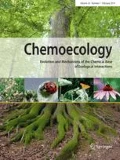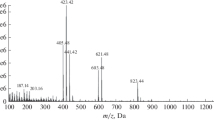Abstract
Ellagitannins are widely distributed plant polyphenols showing potent anti-herbivore activities, but rather complex chemical structures. Here we show how ellagitannins with different structures can be efficiently characterized from plant extracts by utilizing the information obtained from four universal methods used for ellagitannin analysis: Sephadex LH-20 gel chromatography, high-performance liquid chromatography, ultraviolet spectroscopy, and mass spectrometry. We show that by combining the information obtained from the ellagitannins’ chromatographic elution order, specific shapes of the ultraviolet spectra, molecular masses and characteristic mass spectral fragmentations, it is possible to classify these polyphenols into different ellagitannin sub-groups, and even characterize the structures within the sub-groups. These findings aid in the fast screening of complex plant samples for their ellagitannin composition without having to isolate compounds for individual characterization.







Similar content being viewed by others
References
Appel HM (1993) Phenolics in ecological interactions: the importance of oxidation. J Chem Ecol 19:1521–1552
Asquith TN, Butler LG (1986) Interactions of condensed tannins with selected proteins. Phytochemistry 25:1591–1593
Barbehenn RV, Jones CP, Hagerman AE, Karonen M, Salminen J-P (2006a) Ellagitannins have greater oxidative activities than condensed tannins or galloyl glucoses at high pH: potential impact on caterpillars. J Chem Ecol 32:2253–2267
Barbehenn RV, Jones CP, Karonen M, Salminen J-P (2006b) Tannin composition affects the oxidative activities of tree leaves. J Chem Ecol 32:2235–2251
Barbehenn RV, Weir Q, Salminen J-P (2008) Oxidation of ingested phenolics in the tree-feeding caterpillar Orgyia leucostigma depends on foliar chemical composition. J Chem Ecol 34:748–756
Barbehenn RV, Jaros A, Lee G, Mozola C, Weir Q, Salminen J-P (2009) Hydrolysable tannins as “quantitative defenses”: limited impact against Lymantria dispar caterpillars on hybrid poplar. J Insect Physiol 55:297–304
Clausen TP, Provenza FD, Burritt EA, Reichardt PB, Bryant JP (1990) Ecological implications of condensed tannin structure: a case study. J Chem Ecol 16:2381–2392
Doig AJ, Williams DH, Oelrichs PB, Baczynskyj L (1990) Isolation and structure elucidation of punicalagin, a toxic hydrolysable tannin, from Terminalia oblongata. J Chem Soc Perkin Trans 1:2317–2321
Friedman M, Jürgens HS (2000) Effect of pH on the stability of plant phenolic compounds. J Agric Food Chem 48:2101–2110
Gao H, Huang Y-N, Xu P-Y, Kawabata J (2007) Inhibitory effect on α-glucosidase by the fruits of Terminalia chebula Retz. Food Chem 105:628–634
Gross GG (2009) Biosynthesis of ellagitannins: old ideas and new solutions. In: Quideau S (ed) Chemistry and biology of ellagitannins. An underestimated class of bioactive plant polyphenols. World Scientific, Singapore, pp 94–118
Gross EM, Brune A, Walenciak O (2008) Gut pH, redox conditions and oxygen levels in an aquatic caterpillar: potential effects on the fate of ingested tannins. J Insect Physiol 54:462–471
Haddock EA, Gupta RK, Al-Shafi SMK, Layden K, Haslam E, Magnolato D (1982) The metabolism of gallic acid and hexahydroxydiphenic acid in plants: biogenetic and molecular taxonomic considerations. Phytochemistry 21:1049–1062
Hagerman AE (2012) The tannin handbook. http://www.users.muohio.edu/hagermae/. Accessed 4 December 2012
Hagerman AE, Butler LG (1981) The specificity of proanthocyanidin-protein interactions. J Biol Chem 256:4494–4497
Hatano T, Yasuhara T, Matsuda M, Yazaka K, Yoshida T, Okuda T (1990) Oenothein B, a dimeric, hydrolysable tannin with macrocyclic structure, and accompanying tannins from Oenothera erythrosepala. J Chem Soc Perkin Trans I 10:2735–2743
Hofmann T, Glabasnia A, Schwartz B, Wisman KN, Gangwer KA, Hagerman AE (2006) Protein binding and astringent taste of a polymeric procyanidin, 1,2,3,4,6-penta-O-galloyl-β-d-glucopyranose, castalagin, and grandinin. J Agric Food Chem 54:9503–9509
Ito H, Yamaguchi K, Kim T-H, Khennouf S, Gharzouli K, Yoshida T (2002) Dimeric and trimeric hydrolysable tannins from Quercus coccifera and Quercus suber. J Nat Prod 65:339–345
Johnson KS, Barbehenn RV (2000) Oxygen levels in the gut lumens of herbivorous insects. J Insect Physiol 46:897–903
Karonen M, Parker J, Agrawal A, Salminen J-P (2010) First evidence of hexameric and heptameric ellagitannins in plants detected by liquid chromatography/electrospray ionization mass spectrometry. Rapid Commun Mass Spectrom 24:3151–3156
Khanbabaee K, van Ree T (2001) Tannins: classification and definition. Nat Prod Rep 18:641–649
Kilkowski WJ, Gross GG (1999) Color reaction of hydrolysable tannins with Bradford reagent, Coomassie brilliant blue. Phytochemistry 51:363–366
Moilanen J, Salminen J-P (2008) Ecologically neglected tannins and their biologically relevant activity: chemical structures of plant ellagitannins reveal their in vitro oxidative activity at high pH. Chemoecology 18:73–83
Mole S, Rogler JC, Butler LG (1993) Growth reduction by dietary tannins: different effects due to different tannins. Biochem Syst Ecol 21:667–677
Mueller-Harvey I (2001) Analysis of hydrolysable tannins. Anim Feed Sci Technol 91:3–20
Niemetz R, Gross G (2005) Enzymology of gallotannins and ellagitannin biosynthesis. Phytochemistry 66:2001–2011
Okuda T, Yoshida T, Hatano T (1989) New methods of analyzing tannins. J Nat Prod 52:1–31
Okuda T, Yoshida T, Hatano T (1993) Classification of oligomeric hydrolysable tannins and specificity of their occurrence in plants. Phytochemistry 32:507–521
Okuda T, Yoshida T, Hatano T (2000) Correlation of oxidative transformations of hydrolysable tannins and plant evolution. Phytochemistry 55:513–529
Okuda T, Yoshida T, Hatano T, ITO H (2009) Ellagitannins renewed the concept of tannins. In: Quideau S (ed) Chemistry and biology of ellagitannins. An underestimated class of bioactive plant polyphenols. World Scientific, Singapore, pp 1–55
Pfundstein B, El Desouky SK, Hull WE, Haubner R, Erben G, Owen R (2010) Polyphenolic compounds in the fruits of Egyptian medicinal plants (Terminalia bellerica, Terminalia chebula and Terminalia horrida): characterization, quantitation and determination of antioxidant capacities. Phytochemistry 71:1132–1148
Quideau S, Jourdes M, Saucier C, Glories Y, Pardon P, Baudry C (2003) DNA topoisomerase inhibitor acutissimin A and other flavano-ellagitannins in red wine. Angew Chem Int Ed 42:6012–6014
Quideau S, Jourdes M, Lefeuvre D, Montaudon D, Saucier C, Glories Y, Pardon P, Pourquier P (2005) The chemistry of wine polyphenolic C-glycosidic ellagitannins targeting human topoisomerase II. Chem Eur J 11:6503–6513
Salminen J-P, Karonen M (2011) Chemical ecology of tannins and other phenolics: we need a change in approach. Funct Ecol 25:325–338
Salminen J-P, Lempa K (2002) Effects of hydrolysable tannins on an herbivorous insect: fate of individual tannins in insect digestive tract. Chemoecology 12:203–211
Salminen J-P, Ossipov V, Haukioja E, Pihlaja K (2001) Seasonal variation in the content of hydrolysable tannins in leaves of Betula pubescens. Phytochemistry 57:15–22
Salminen J-P, Roslin T, Karonen M, Sinkkonen J, Pihlaja K, Pulkkinen P (2004) Seasonal variation in the content of hydrolyzable tannins, flavonoid glycosides and proanthocyanidins in oak leaves. J Chem Ecol 30:1693–1711
Salminen J-P, Karonen M, Sinkkonen J (2011) Chemical ecology of tannins: recent developments in tannin chemistry reveal new structures and structure-activity patterns. Chem Eur J 17:2806–2816
Scalbert A, Duval L, Peng S, Monties B, Du Penhoat C (1990) Polyphenols of Quercus robur L. II. Preparative isolation by low-pressure and high-pressure liquid chromatography of heartwood ellagitannins. J Chromatogr 502:107–119
Silva O, Gomes ET, Wolfender J-L, Marston A, Hostettmann K (2000) Application of high performance liquid chromatography coupled with ultraviolet spectroscopy and electrospray mass spectrometry to the characterisation of ellagitannins from Terminalia macroptera roots. Pharm Res 17:1396–1401
Yarnes CT, Boecklen WJ, Tuominen K, Salminen J-P (2006) Defining phytochemical phenotypes: size and shape analysis of phenolic compounds in oaks (Fagaceae, Quercus) of the Chihuahuan desert. Can J Bot 84:1233–1248
Yarnes CT, Boecklen WJ, Salminen J-P (2008a) No simple sum: seasonal variation in tannin phenotypes and leaf-miners in hybrid oaks. Chemoecology 18:39–51
Yarnes CT, Boecklen WJ, Tuominen K, Salminen J-P (2008b) Hybridization affects seasonal variation of phytochemical phenotypes in an oak hybrid complex (Quercus gambelii × Quercus grisea). Int J Plant Sci 169:567–578
Yoshida T, Ohbayashi H, Ishihara K, Ohwashi W, Haba K, Okano Y, Shingu T, Okuda T (1991a) Tannins and related polyphenols of Melastomataceous plants. I. Hydrolyzable tannins from Tibouchina semidecandra COGN. Chem Pharm Bull 39:2233–2240
Yoshida T, Chou T, Matsuda M, Yasuhara T, Yazaki K, Hatano T, Nitta A, Okuda T (1991b) Woodfordin D and oenothein A, trimeric hydrolysable tannins of macro-ring structure with antitumor activity. Chem Pharm Bull 39:1157–1162
Yoshida T, Chou T, Shingu T, Okuda T (1995) Oenotheins D, F and G, hydrolysable tannin dimers from Oenothera laciniata. Phytochemistry 40:555–561
Yoshida T, Ito H, Hipolito IJ (2005) Pentameric ellagitannin oligomers in melastomataceous plants—chemotaxonomic significance. Phytochemistry 66:1972–1983
Yoshida T, Hatano T, Ito H, Okuda T (2009) Structural diversity and antimicrobial activities of ellagitannins. In: Quideau S (ed) Chemistry and biology of ellagitannins. An underestimated class of bioactive plant polyphenols. World Scientific, Singapore, pp 55–93
Yoshida T, Amakura Y, Yoshimura M (2010) Structural features and biological properties of ellagitannins in some plant families of the order Myrtales. Int J Mol Sci 11:79–106
Acknowledgments
The authors thank Maarit Karonen, Jaana Liimatainen, Matti Vihakas and Anu Tuo-minen for their comments on the earlier versions of the manuscript. Chris Yarnes and Kati Tuominen are acknowledged for their help with the purification of Quercus gambelii ellagitannins. This work was supported by the Academy of Finland (Grant No 119659 and 258992 to JPS) and the Kone Foundation (JM).
Author information
Authors and Affiliations
Corresponding author
Electronic supplementary material
Below is the link to the electronic supplementary material.
Rights and permissions
About this article
Cite this article
Moilanen, J., Sinkkonen, J. & Salminen, JP. Characterization of bioactive plant ellagitannins by chromatographic, spectroscopic and mass spectrometric methods. Chemoecology 23, 165–179 (2013). https://doi.org/10.1007/s00049-013-0132-3
Received:
Accepted:
Published:
Issue Date:
DOI: https://doi.org/10.1007/s00049-013-0132-3




